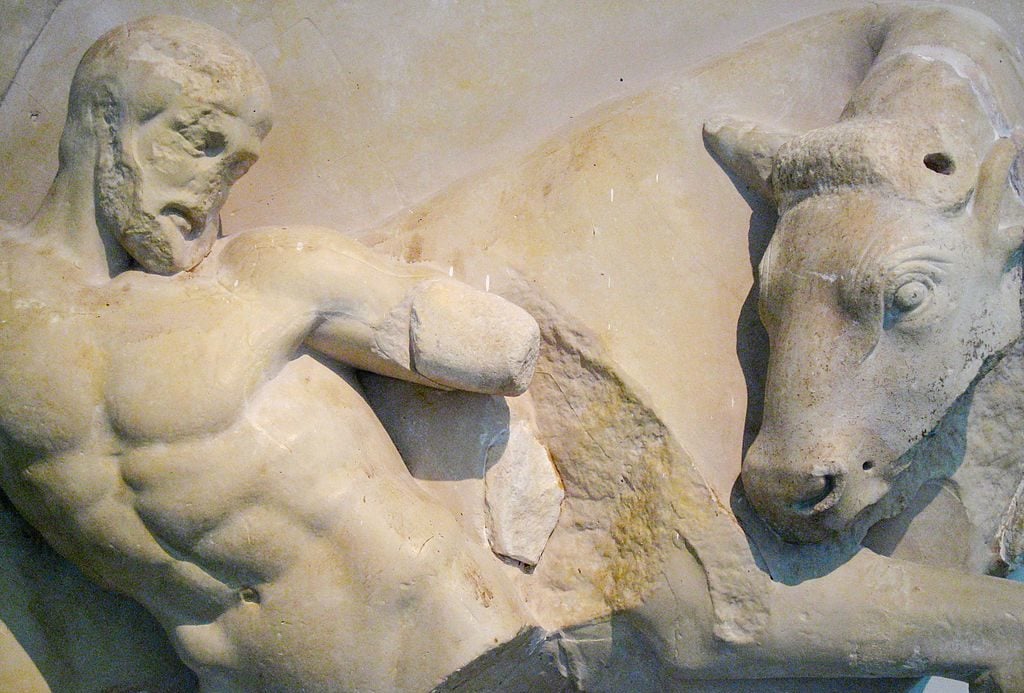
The Twelve Labors of Hercules, or Herakles (Greek: οἱ Ἡρακλέους ἆθλοι, hoi Hērakléous âthloi) occupy a special place in the pantheon of Greek mythology, and in the worldview of the ancient Greeks.
Touching on the themes of madness, murder, and atonement, the Twelve Labors of Hercules exemplify a great many of the ancient beliefs of the Greeks about human nature, and even explain how the constellations and the Milky Way itself were formed.
Many areas in Greece, especially on the Peloponnesian Peninsula, are mentioned as part of the Labors he performed, and many of them today are recognized for the part they played in Greek mythology.
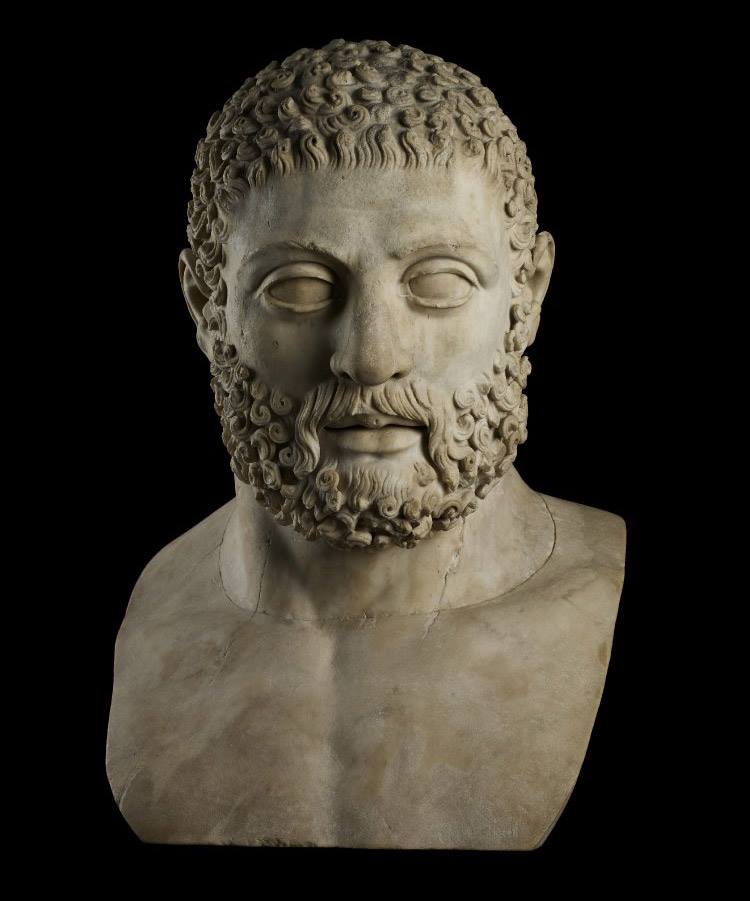
The mythological figure’s “Labors” are a series of feats carried out as penance for crimes he committed yet was not fully responsible for like so many other figures from Greek mythology, such as Oedipus, he was a tragic individual, fated to carry out his crimes by powers that controlled his life.
Herakles, whose name was later Romanized as Hercules, was the greatest of all Greek heroes. He undertook his feats at the service of King Eurystheus, who was continually portrayed as being a comic figure who was cowed by the great man’s strength and derring-do.
The Twelve Labors were later connected by a continuous narrative, in the form of one epic poem, which has tragically since been now lost, written by Peisander, dating back to about 600 BC.
Hera, the wife of the Greek god Zeus, had tried to kill Hercules ever since he was born because she was angry that her husband had fathered him with the lovely Alcmene. After being tricked into suckling the infant, she was fixated on getting revenge for the indignity. She sent two snakes into his crib, but he dispatched them immediately with the strength that he had received from Hera through her milk.
She later induced a madness in Hercules that made him unknowingly kill his wife, Megara, and their sons. Our hero, filled with shame and racked with guilt, went to Pythia, the Oracle of Delphi to atone. He prayed to the god Apollo for guidance, and was told to go to Tiryns to serve the king of Mycenae, Eurystheus, for ten years as atonement for his crimes.
He was then tasked with performing a series of astoundingly difficult feats, called Labors, which took place all over ancient Greece. If he succeeded, he would not only atone for his crimes but be rewarded with immortality as well.
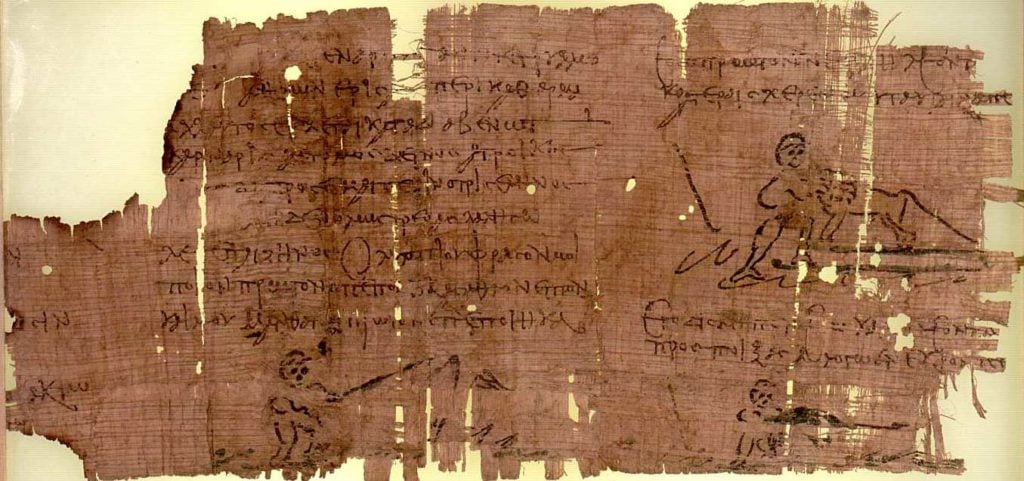
Hercules actually despaired at the words of the Oracle, loath to serve a man whom he knew to be far inferior to himself yet fearing to oppose his father, Zeus. Eventually, he placed himself at King Eurystheus’ disposal.
Eurystheus originally ordered Hercules to perform ten labors. He duly accomplished these tasks, but Eurystheus refused to recognize two of them: the slaying of the Lernaean Hydra, since Heracles’ nephew and charioteer Iolaus had helped him, and the cleansing of the Augean stables because Heracles had accepted payment for the labor.
The king set two more tasks (fetching the Golden Apples of Hesperides and capturing the dog Cerberus), which Heracles also performed, bringing the total number of tasks to twelve.
The Twelve Labors of Hercules
Of the Twelve Labors of Hercules, the first six were located in the Peloponnesian Peninsula. Six others took the hero farther afield, to places that were all previously strongholds of Hera or the ‘Goddess,’ and were believed to be entrances to the Netherworld.
In each case, the pattern was the same: Hercules was sent to kill or subdue, or to fetch back for King Eurystheus a magical animal or plant.
In the completion of his monumental tasks, Hercules was sometimes accompanied by a male companion (an eromenos), or Iolaus, his nephew. A traditional order of the Twelve Labors of Hercules found in the “Bibliotheca,” by Pseudo-Apollodorus is:
Slaying the Nemean lion.
Slaying the nine-headed Lernaean Hydra.
Capturing the Ceryneian Hind.
Capturing the Erymanthian Boar.
Cleaning the Augean stables in a single day.
Slaying the Stymphalian birds.
Capturing the Cretan Bull.
Stealing the Mares of Diomedes.
Obtaining the girdle of Hippolyta, queen of the Amazons.
Obtaining the cattle of the three-bodied giant Geryon.
Stealing three of the golden apples of the Hesperides.
Capturing and bringing back Cerberus, the dog belonging to Hades.
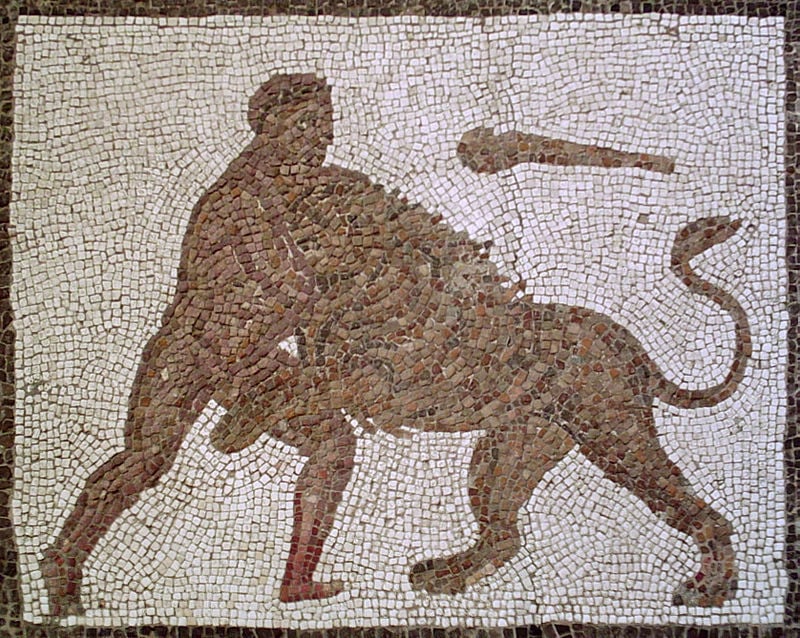
Slaying the Nemean Lion
Hercules wandered until he came to the town of Cleonae. There, he met a boy who said that if he slew the Nemean lion and returned alive within thirty days, the town would sacrifice a lion to Zeus. However, if Hercules did not return within thirty days, or if he died, the boy would sacrifice himself to Zeus.
Another version of the story says that he met Molorchos, a shepherd who had lost his son to the lion, saying that if he came back within thirty days, a ram would be sacrificed to Zeus. If he did not return within thirty days, it would be sacrificed to the dead Heracles as an offering of mourning.
When he found and shot the lion, firing at it with his bow, he discovered the fur’s protective property as the arrow bounced harmlessly off the creature’s thigh.
After some time, Hercules made the lion return to his cave. In those close quarters, Heracles was able to stun the beast with his club and, using his immense strength, strangle it to death.
During the fight the lion bit off one of his fingers. Others say that he shot arrows at it, eventually shooting it in the unarmored mouth. After slaying the lion, our hero tried to skin it with a knife from his belt, but failed. He then tried sharpening the knife with a stone — and even tried with the stone itself. Finally, the goddess Athena, noticing the hero’s plight, told Heracles to use one of the lion’s own claws to skin the pelt.
When he returned on the 30th day carrying the carcass of the lion on his shoulders, King Eurystheus was amazed and terrified. Afraid of the man’s incredible powers, Eurystheus forbade him ever again to enter the city; from then on he was to display the fruits of his labors outside the city gates.
Eurystheus would not even announce Hercules’ tasks personally, opting to go through a herald. The king was so afraid of he hero’s incredible power that he even had a large bronze jar made for himself in which to hide from Hercules if the need arose. Eurystheus then warned Hercules that his assigned tasks would become increasingly difficult.
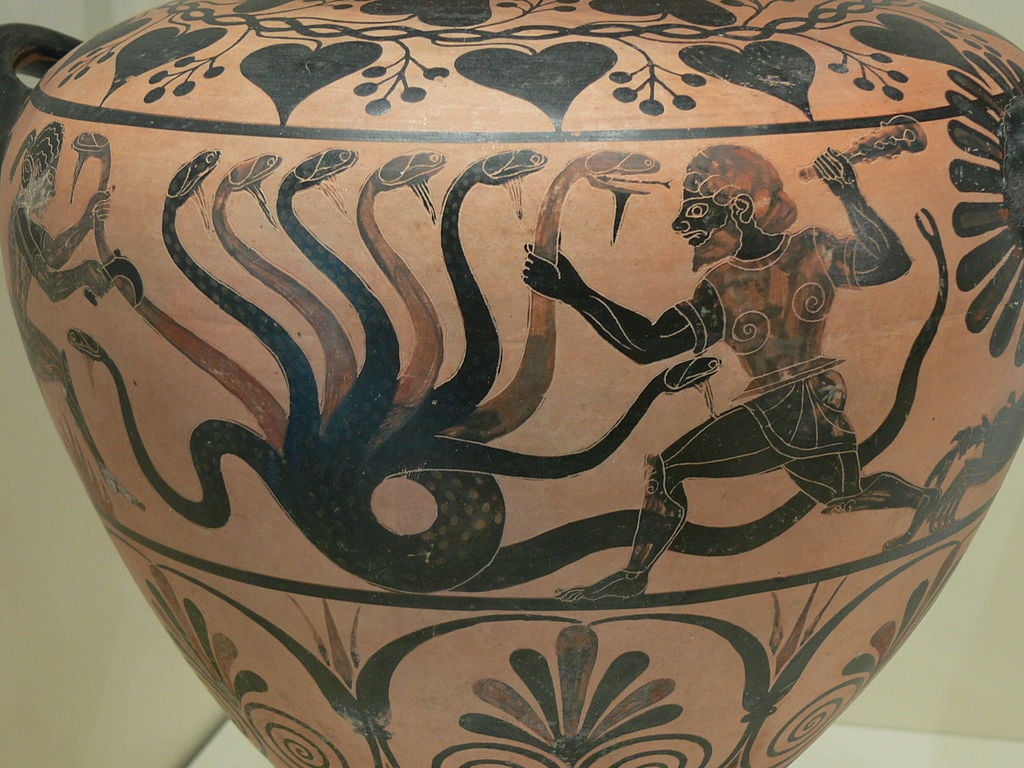
Hercules and the Lernaean Hydra
Hercules’ second labor was to slay the Lernaean Hydra, which Hera had specifically raised in order to slay him. Upon reaching the swamp near Lake Lerna, where the Hydra dwelt, Hercules used a cloth to cover his mouth and nose to protect himself from the poisonous fumes. He fired flaming arrows into the Hydra’s lair, the spring of Amymone, which was in a deep cave that it only emerged from to terrorize nearby villages.
He then confronted the Hydra, wielding either a harvesting sickle, a sword or his famed club. But of course, upon cutting off each of its heads he found that two grew back — an expression of the hopelessness of such a struggle for any but our hero. Additionally, one of the Hydra’s heads, the middle one, was immortal.
The details of the struggle are laid out in the Bibliotheca: realizing that he could not defeat the Hydra in this way, Hercules called on his nephew Iolaus for help. His nephew then came upon the idea (possibly inspired by Athena) of using a firebrand to scorch the neck stumps after each decapitation.
Hercules cut off each head and Iolaus then cauterized the open stumps. Seeing that Hercules was winning the struggle, Hera sent a giant crab to distract him but of course crushed it under his foot.
He cut off the Hydra’s one immortal head with a golden sword which had been given to him by Athena. Hercules placed it under a great rock on the sacred way between Lerna and Elaius, and dipped his arrows in the Hydra’s poisonous blood, thereby completing his second task.
Hera, upset that Hercules had slain the beast that she had raised to kill him, placed it in the dark blue vault of the sky as the constellation Hydra. She then turned the crab into the constellation Cancer.
Later, Hercules used an arrow dipped in the Hydra’s poisonous blood to kill the centaur Nessus, and Nessus’ tainted blood was applied to the tunic of Nessus by which the centaur had his posthumous revenge on Hercules.
Both the geographer Strabo and the Greek writer Pausanias stated that the stench of the river Anigrus in Elis, making all the fish of the river inedible, was reputed to be due to the Hydra’s venom, which had been washed from the arrows Hercules used on the centaur.
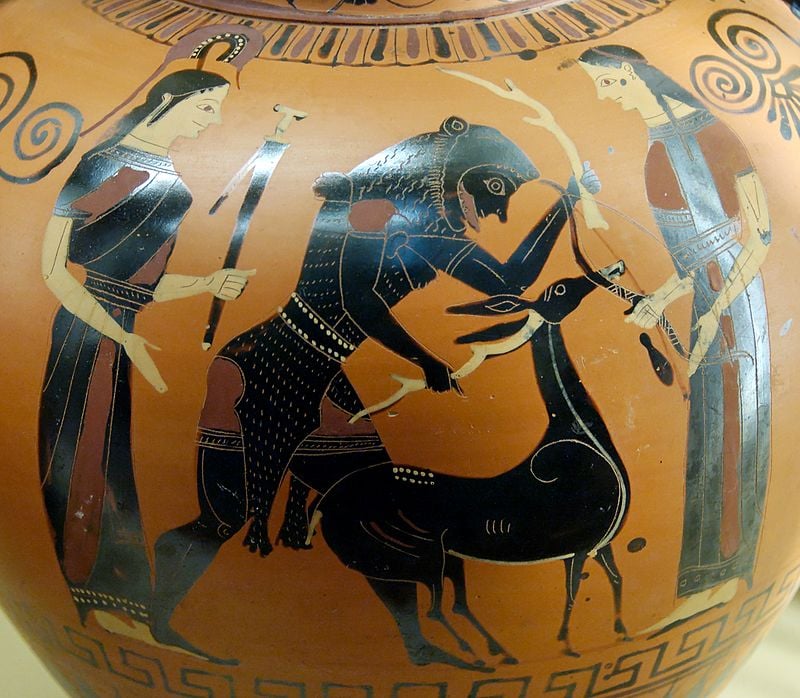
Hercules captures the Ceryneian Hind
Eurystheus and Hera were greatly angered that Hercules had survived both the Nemean Lion and the Lernaean Hydra. For the third labor, they found a task which they thought would spell doom for the hero. Since it was clear that Hercules could overcome even the most fearsome opponents by his great strength, Eurystheus ordered him to capture the Ceryneian Hind, which was so fast that it could outrun an arrow.
One day, Hercules awoke from sleeping and spotted the hind by a glint of sunlight on its antlers. Hercules then chased the animal on foot through Greece, Thrace, Istria, and the land of the Hyperboreans for one entire year.
In some versions of the story, he captured the hind while it slept; in other versions, Artemis told him to leave the hind and tell Eurystheus all that had happened, and his third labor would be considered to be completed. Yet another version states that Heracles brought down the Hind with an arrow between its forelegs.
King Eurystheus had given Hercules this task hoping to incite Artemis’ anger at Heracles for his desecration of her sacred animal. As he was returning with the hind, Hercules encountered Artemis and her brother Apollo. He begged the goddess for forgiveness, explaining that he had to catch it as part of his penance, but he promised to return it.
Artemis forgave him, foiling Eurystheus’ plan.
Upon bringing the hind to Eurystheus, Hercules was told that it was to become part of the King’s menagerie. Hercules knew that he had to return the hind as he had promised, so he agreed to hand it over as long as Eurystheus himself came out and took it from him.
The King then appeared, but the moment that Hercules let the hind go, it sprinted back to its mistress; Hercules left, commenting that Eurystheus had not been quick enough.
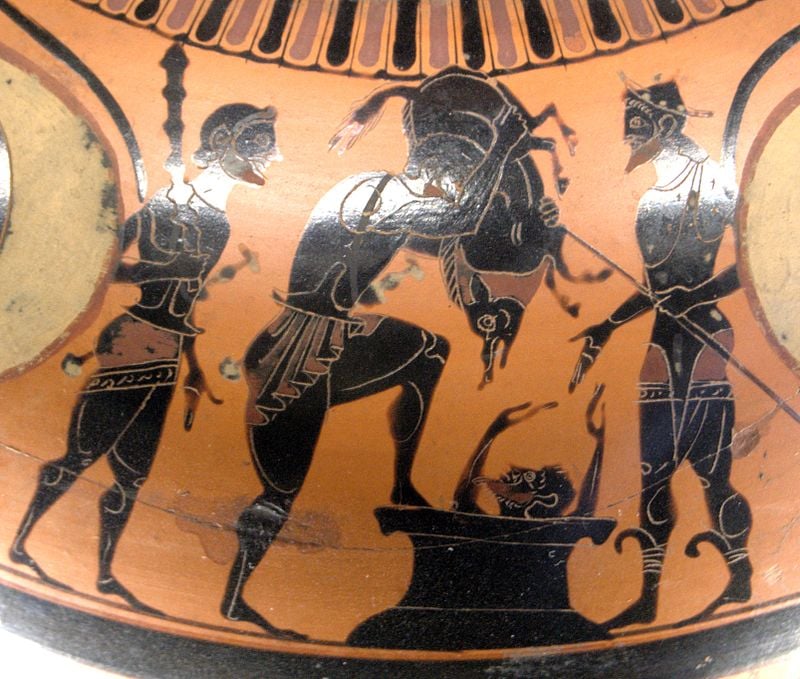
Heracles and the Erymanthian Boar
By some accounts, the fourth labor was to bring the fearsome Erymanthian Boar back to Eurystheus alive. On the way to Mount Erymanthos where the boar lived, Hercules visited Pholus (“the caveman”), a kind and hospitable centaur and old friend. Hercules ate with Pholus in his cavern and asked for wine. Pholus had only one jar of wine, a gift from Dionysus to all the centaurs on Mount Erymanthos.
Hercules convinced him to open it, and the scent attracted the other centaurs. They did not understand that wine needs to be tempered with water, so they became drunk and attacked Hercules. He shot at them with his poisonous arrows, killing many, and the centaurs retreated all the way to Chiron’s cave.
Pholus was curious why the arrows caused so much death. He picked one up but dropped it, and the arrow stabbed his hoof, poisoning him. One version states that a stray arrow hit Chiron as well. He was immortal, but he still felt the pain.
Chiron’s pain was so great that he volunteered to give up his immortality and take the place of Prometheus, who had been chained to the top of a mountain to have his liver eaten daily by an eagle. Prometheus’ torturer, the eagle, continued its tormenting of Chiron, so Hercules shot it dead with an arrow.
The tale is believed to be meant to show Hercules as being the recipient of Chiron’s surrendered immortality. However, this tale contradicts the fact that Chiron later taught Achilles. The tale of the centaurs sometimes appears in other parts of the twelve labors, as does the freeing of Prometheus.
Hercules had visited Chiron to gain advice on how to catch the boar, and Chiron had told him to drive it into thick snow, which sets this labor in mid-winter. Hercules indeed caught the boar, bound it, and carried it back to King Eurystheus, who was so frightened of it that he ducked down in his custom-made storage pithos, begging Hercules to get rid of the fearsome beast.

Hercules cleans Augean stables by redirecting river
The fifth labor was to clean the stables of King Augeas. This assignment was intended to be both humiliating and impossible, since these divine livestock were immortal, and produced prodigious quantities of manure. The Augean stables had not been cleaned in over thirty years, and over a thousand cattle lived there.
However, Hercules succeeded by rerouting the rivers Alpheus and Peneus to wash out the filth.
Before starting on the gargantuan task, Hercules had asked Augeas for one-tenth of the cattle if he finished the task in one day, and Augeas agreed; however, Augeas refused to honor the agreement on the grounds that Heracles had been ordered to carry out the task by Eurystheus anyway.
Hercules claimed his reward in court, and was supported by Augeas’ son Phyleus. Augeas banished them both before the court had ruled. Heracles returned, slew Augeas, and gave his kingdom to Phyleus.
The success of this labor was ultimately discounted as the rushing waters had done the work of cleaning the stables, and because Heracles was paid for completing the task; King Eurystheus therefore determined that Hercules still had seven labors to perform.
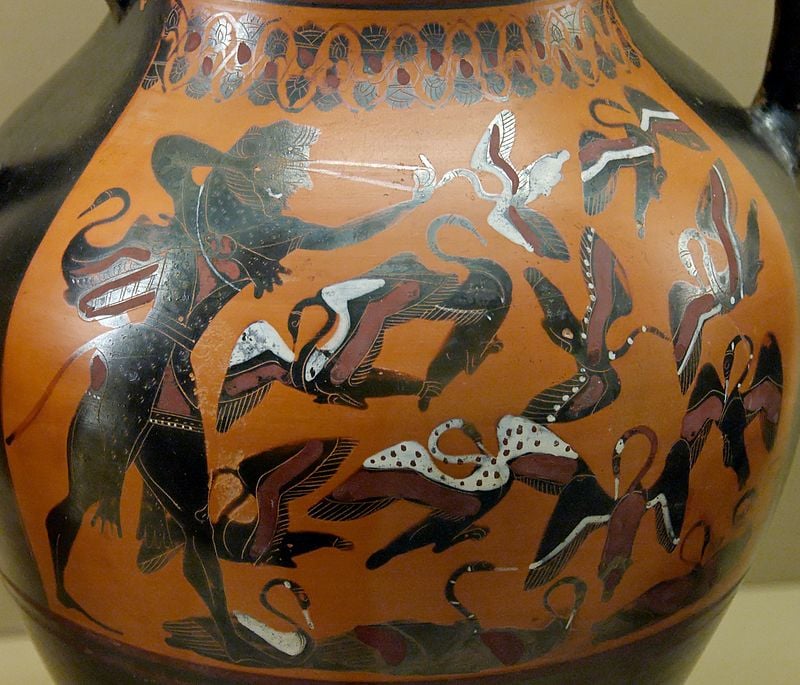
Hercules and the Stymphalian birds
The sixth labor was to defeat the Stymphalian birds, who were known to eat men, having beaks made of bronze and sharp metallic feathers which they could launch at their victims.
The avians were sacred to Ares, the Greek god of war. In addition, their droppings were highly toxic. They had migrated to Lake Stymphalia in Arcadia, where they bred quickly and took over the countryside, destroying local crops, fruit trees, and even townspeople.
Hercules could not go too far into the swamp where they dwelt because it would not support his weight. Athena, taking pity on Hercules, gave him a rattle which Hephaestus had made especially for the occasion. Heracles shook the rattle and frightened the birds into the air. Hercules s then shot many of them with his arrows.
The rest flew far away, never to return. The Argonauts would later encounter these creatures in their own exploits.

Hercules forces the Cretan Bull to the ground
The seventh labor was to capture the Cretan Bull, the father of the Minotaur. Hercules sailed to the island of Crete, where King Minos gave him permission to take the bull away, and even offered him assistance.
The bull had been wreaking havoc on Crete by uprooting crops and leveling orchard walls. Hercules snuck up behind the powerful animal and then used his hands to throttle it (stopping before it was killed), and then shipping it back to Tiryns.
King Eurystheus, who hid again in his pithos at the sight of the creature, wanted to sacrifice the bull to Hera, who hated Hercules. She refused the sacrifice because it reflected glory on Hercules. The bull was then released and wandered into Marathon, becoming known as the Marathonian Bull. Theseus would later sacrifice the bull to Athena and/or Apollo.
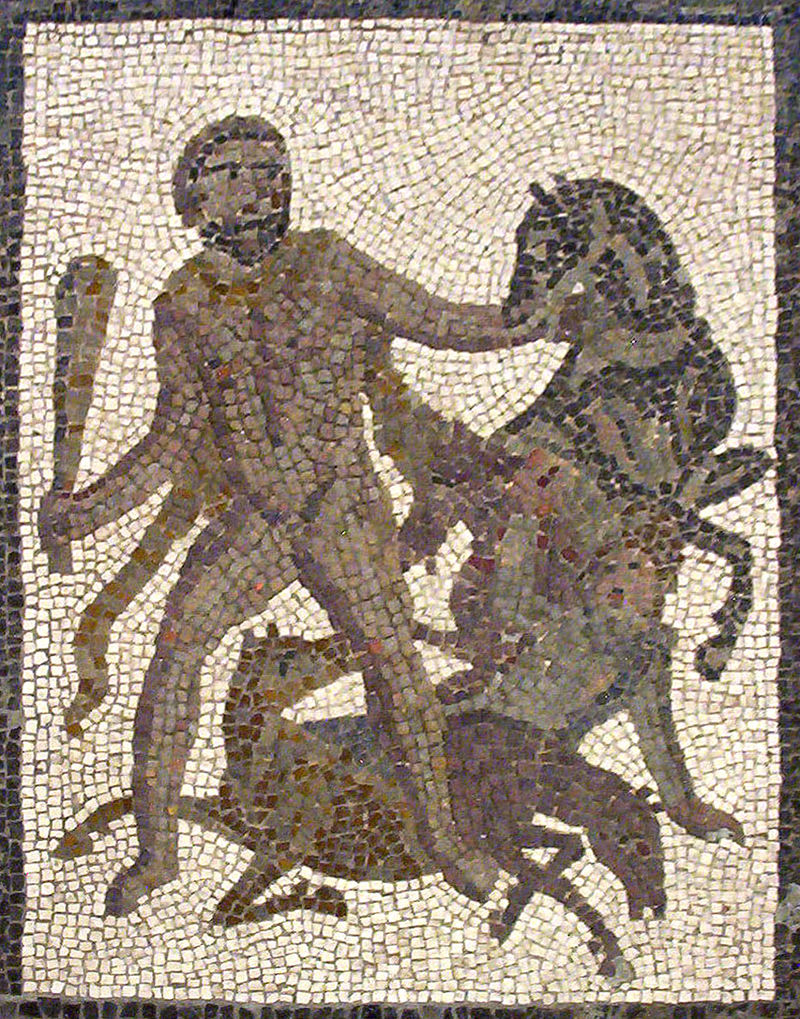
The Mares of Diomedes
As the eighth of his Twelve Labors, also categorized as the second of the Non-Peloponneisan labors, Hercules was sent by King Eurystheus to steal the Mares from Diomedes. The mares’ madness was attributed to their unnatural diet which consisted of the flesh of unsuspecting guests or strangers to the island.
Some versions of the myth say that the mares also expelled fire when they breathed. The Mares, which were the terror of Thrace, were kept tethered by iron chains to a bronze manger in the now vanished city of Tirida. They were named Podargos (The Swift), Lampon (The Shining), Xanthos (The Yellow), and Deinos (or Deinus, The Terrible).
In one version of this feat, Herakles brought a number of volunteers to help him capture the giant horses. After overpowering Diomedes’ men, he broke the chains that tethered the horses and drove the mares down to sea.
Unaware that they were man-eating and uncontrollable, Heracles left them in the charge of his favored companion, Abderus, while he left to fight Diomedes. Upon his return, Heracles found that the boy had been eaten. As revenge, Heracles fed Diomedes to his own horses and then founded Abdera next to the boy’s tomb.
In another version, Heracles, who was visiting the island, stayed awake so that he didn’t have his throat cut by Diomedes in the night and cut the chains binding the horses once everyone was asleep. Having scared the horses onto the high ground of a knoll, Heracles quickly dug a trench through the peninsula, filling it with water and thus flooding the low-lying plain. When Diomedes and his men turned to flee, Heracles killed them with an axe and fed Diomedes’ body to the horses to calm them.
In yet another version, Heracles first captured Diomedes and fed him to the mares before releasing them. Only after realizing that their King was dead did his men, the Bistonians, attack Heracles. Upon seeing the mares charging at them, led in a chariot by Abderus, the Bistonians turned and fled.
All the versions of this disturbing story relate how eating human flesh makes the horses calmer, giving Heracles the opportunity to bind their mouths shut, and easily take them back to King Eurystheus, who dedicated the horses to Hera.
In some versions, they were allowed to roam freely around Argos, having become tamed, but in others, Eurystheus ordered the horses taken to Olympus to be sacrificed to Zeus. He refused them, however, and sent wolves, lions, and bears to kill them.
After this feat was accomplished by our hero, King Eurystheus sent Heracles to bring back Hippolyta’s Girdle.
The Magic belt of Hippolyta, Queen of the Amazons
King Eurystheus’ daughter Admete desired the Belt of Hippolyta, queen of the Amazons, which had been a gift from her father Ares. To please his daughter, Eurystheus ordered Heracles to retrieve the belt as his ninth great labor.
Taking a band of friends with him, Heracles set sail, stopping at the island of Paros, which was inhabited by the sons of Minos. Herakles took two of Minos’ grandsons, Alcaeus and Sthenelus, continuing on their voyage and landing at the court of Lycus, whom Heracles defended in a battle against King Mygdon of Bebryces. After killing King Mygdon, Heracles gave much of the land to his friend Lycus. Lycus called the land Heraclea. The crew then set off for Themiscyra, where Hippolyta lived.
All would have gone well for Heracles had it not been for Hera. Hippolyta, impressed with Heracles and his exploits, agreed to give him the belt and would have done so had Hera not disguised herself and walked among the Amazons, sowing seeds of distrust.
She claimed the strangers were plotting to carry off the queen of the Amazons. Alarmed, the women set off on horseback to confront Heracles. When Heracles saw them, he thought Hippolyta had been plotting such treachery all along and had never meant to hand over the belt, so he killed her, took the belt and returned to Eurystheus.
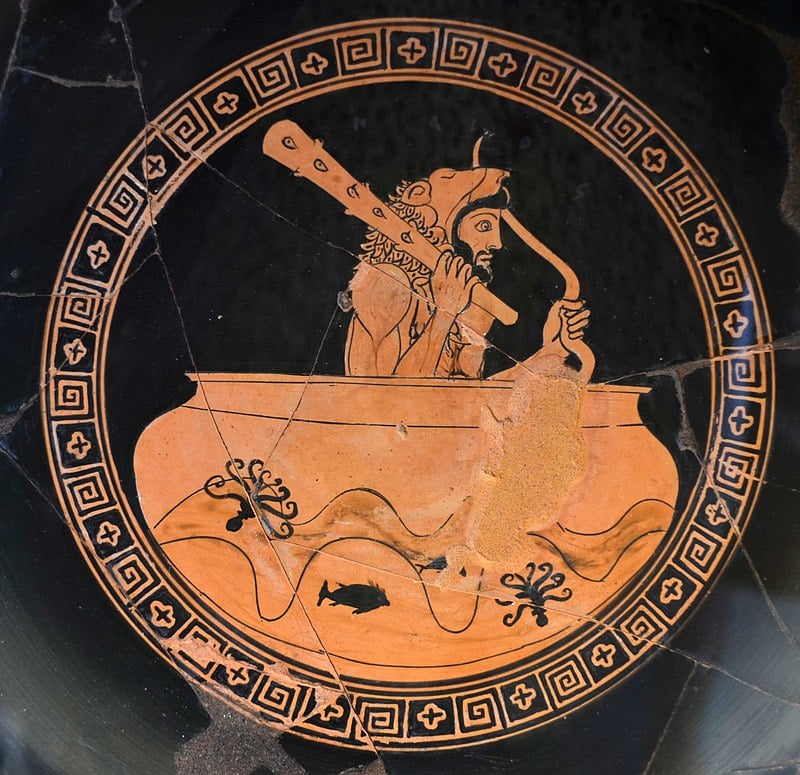
The Cattle of Geryon
The tenth labor was to obtain the Cattle of the three-bodied giant Geryon. In the fullest account in the Bibliotheca of Pseudo-Apollodorus, Heracles had to go to the island of Erytheia in the far west (sometimes identified with the Hesperides, or with the island which forms the city of Cádiz, Spain) to obtain the cattle.
On the way there, he crossed the Libyan desert and became so frustrated at the heat that he shot an arrow at the Sun. The sun-god Helios “in admiration of his courage” gave Heracles the golden cup Helios used to sail across the sea from west to east each night. Heracles delivered the cup to Erytheia.
Heracles portrayed riding in this cup was a favorite motif on Ancient Greek black-figure pottery. Such a magical conveyance, of course, undercuts any literal geographic location for Erytheia, the “red island” of the sunset.
When Heracles landed at Erytheia, he was confronted by the two-headed dog Orthrus. With one blow from his olive-wood club, Heracles killed the beast. Eurytion the herdsman came to assist Orthrus, but Heracles dealt with him the same way.
On hearing the commotion, Geryon sprang into action, carrying three shields and three spears, and wearing three helmets. He attacked Heracles at the River Anthemus, but was slain by one of Heracles’ poisoned arrows. Heracles shot so forcefully that the arrow pierced Geryon’s forehead, “and Geryon bent his neck over to one side, like a poppy that spoils its delicate shapes, shedding its petals all at once” [25].
Heracles then had to herd the cattle back to Eurystheus. In Roman versions of the narrative, Heracles drove the cattle over the Aventine Hill on the future site of Rome. The giant Cacus, who lived there, stole some of the cattle as Heracles slept, making the cattle walk backwards so that they left no trail, a repetition of the trick of the young Hermes. According to some versions, Heracles drove his remaining cattle past the cave, where Cacus had hidden the stolen animals, and they began calling out to each other. In other versions, Cacus’ sister Caca told Heracles where he was. Heracles then killed Cacus, and set up an altar on the spot, later the site of Rome’s Forum Boarium (the cattle market).
To annoy Heracles, Hera sent a gadfly to bite the cattle, irritate them, and scatter them. Within a year, Heracles retrieved them. Hera then sent a flood which raised the level of a river so much that Heracles could not cross with the cattle. He piled stones into the river to make the water shallower. When he finally reached the court of Eurystheus, the cattle were sacrificed to Hera.
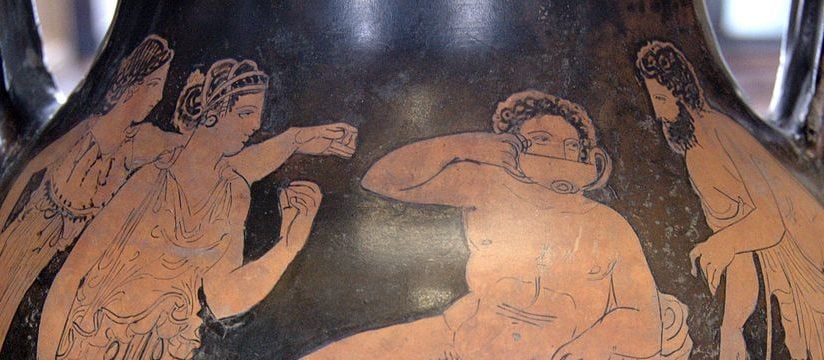
Golden Apples of the Hesperides
After Heracles completed the first ten labors, Eurystheus gave him two more, after claiming that slaying the Hydra and cleaning the Augean Stables did not count.
The first additional labor was to steal three of the golden apples from the garden of the Hesperides. Hercules had to first catch the Old Man of the Sea, the shapeshifting sea god, in order to learn where the Garden of the Hesperides was located.
In some variations of the tale, Hercules, either at the start or at the end of this task, meets Antaeus, who was invincible as long as he touched his mother, Gaia, the Earth. Heracles then killed Antaeus by holding him aloft and crushing him in a bear hug.
Herodotus claims that Hercules stopped in Egypt, where King Busiris decided to make him the yearly sacrifice, but Heracles burst out of his chains.
Hercules finally made his way to the garden of the Hesperides, where he encountered Atlas holding up the heavens on his shoulders. Hercules persuaded Atlas to get the three golden apples for him by offering to hold up the heavens in his place for a little while. Atlas could get the apples because, in this version, he was the father or otherwise related to the Hesperides.
This would have made the labor – like the Hydra and the Augean stables – void because Heracles had received help. When Atlas returned, he decided that he did not want to take the heavens back, and instead offered to deliver the apples himself, but Hercules tricked him by agreeing to remain in place of Atlas on the condition that Atlas relieve him temporarily while Heracles adjusted his cloak.
Atlas agreed, but Hercules reneged and walked away with the apples. According to an alternative version, Hercules slew Ladon, the dragon who guarded the apples instead. King Eurystheus was again furious that Heracles had accomplished something that he had thought could not possibly be done.
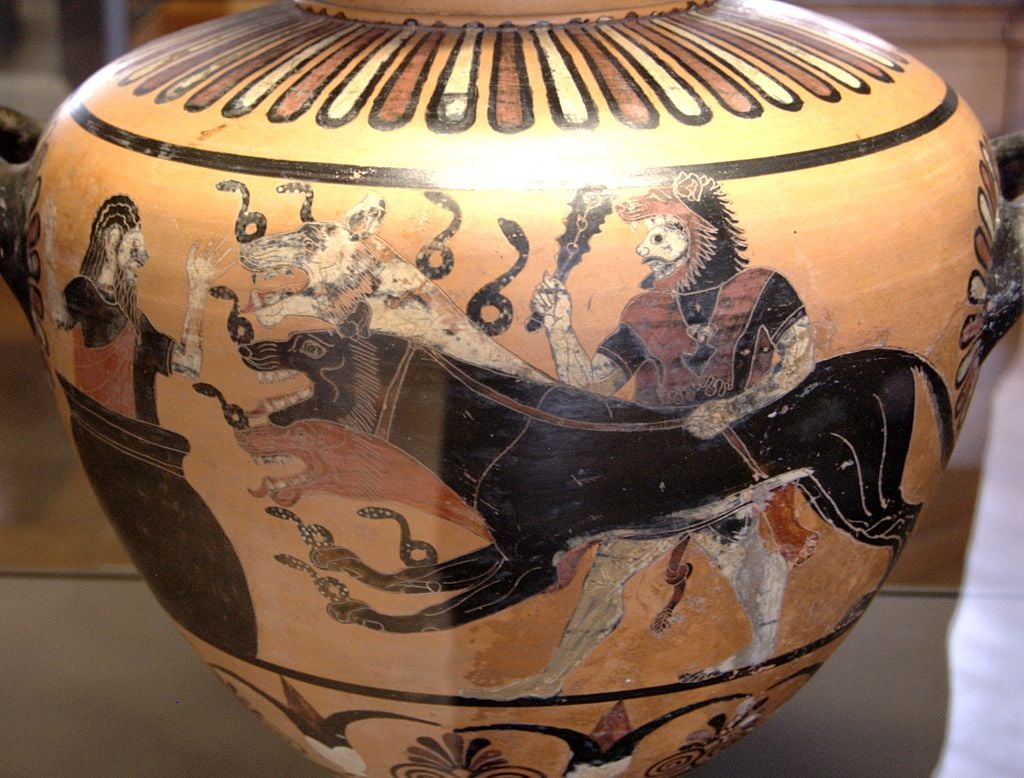
Cerberus, the dog of Hades
The twelfth and final labor was the capture of Cerberus, the three-headed, dragon-tailed dog that was the guardian of the gates of the Underworld. To prepare for his descent into the Underworld, Heracles went to Eleusis (or Athens) to be initiated in the Eleusinian Mysteries. He then entered the Underworld with the gods Hermes and Athena as his guides.
While in the Underworld, Hercules met Theseus and Pirithous. The two companions had been imprisoned by Hades for attempting to kidnap Persephone. One tradition tells of snakes coiling around their legs, then turning into stone; another that Hades feigned hospitality and prepared a feast, inviting them to sit.
They unknowingly sat in chairs of forgetfulness and were permanently ensnared. When Heracles had pulled Theseus first from his chair, some of his thigh stuck to it (this explains the supposedly lean thighs of Athenians), but the Earth shook at the attempt to liberate Pirithous, whose desire to have the goddess for himself was so insulting that he was doomed to stay behind.
Hercules found Hades and asked permission to bring Cerberus to the surface, which Hades agreed to if Hercules could subdue the beast without using weapons. Heracles overpowered Cerberus with his bare hands and slung the beast over his back.
He carried Cerberus out of the Underworld through a cavern entrance in the Peloponnese and brought it to King Eurystheus, who again fled into his pithos in fear. Eurystheus begged Hercules to return Cerberus to the Underworld, offering in return to release him from any further labor when Cerberus disappeared back to his master.
What did he do for an encore?
After completing the Twelve Labors, one tradition says Hercules joined Jason and the Argonauts in their quest for the Golden Fleece. However, Herodorus, who lived c. 400 BC, disputed this and denied Hercules ever sailed with the Argonauts. A separate tradition, the Argonautica, relates Hercules accompanying the Argonauts, but he did not travel with them as far as Colchis.
According to Euripides’ play “Herakles,” it is at this point after his labors are completed and he is returning home to meet his wife and family that he is driven mad and kills them, after which he is exiled from Thebes and leaves for Athens.
He also successfully fought the river god Achelous for the hand of Deianeira, according to some legends. As he was taking her home, a Centaur called Nessus attempted to violate her, and Heracles shot him with one of his poisoned arrows.
As the Centaur lay dying, he told Deianeira to preserve the blood from his wound, and if Heracles wore a garment rubbed with it he would love only her forever. Several years later, however, Heracles fell in love with Iole, the daughter of Eurytus, who was the king of Oechalia.
Deianeira then sent Hercules a garment smeared with the blood of the centaur. A grim plot twist occurred at that point, however, as the blood acted as a powerful poison, and the great Heracles died.
His body was then placed on a pyre on Mount Oeta (Modern Greek Oíti), and his mortal remains were consumed; however, true to his mythological powers, his divine part ascended to heaven, becoming a god. After arriving there he was reconciled to Hera and then married Hebe.
See all the latest news from Greece and the world at Greekreporter.com. Contact our newsroom to report an update or send your story, photos and videos. Follow GR on Google News and subscribe here to our daily email!



